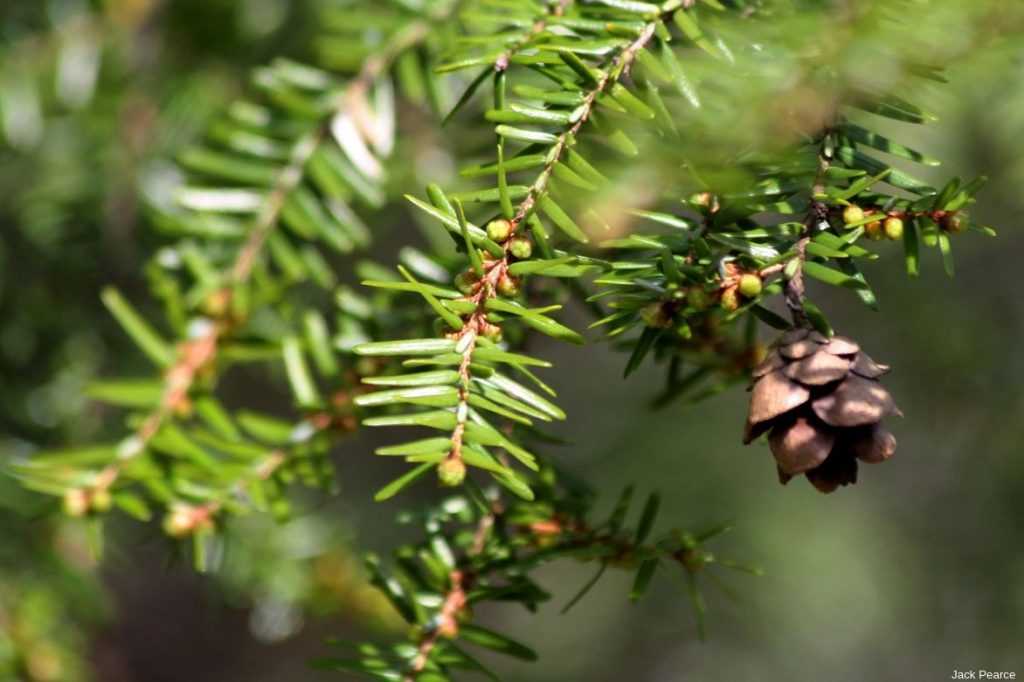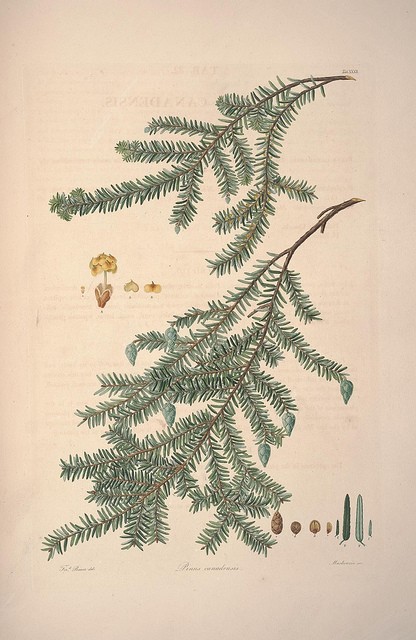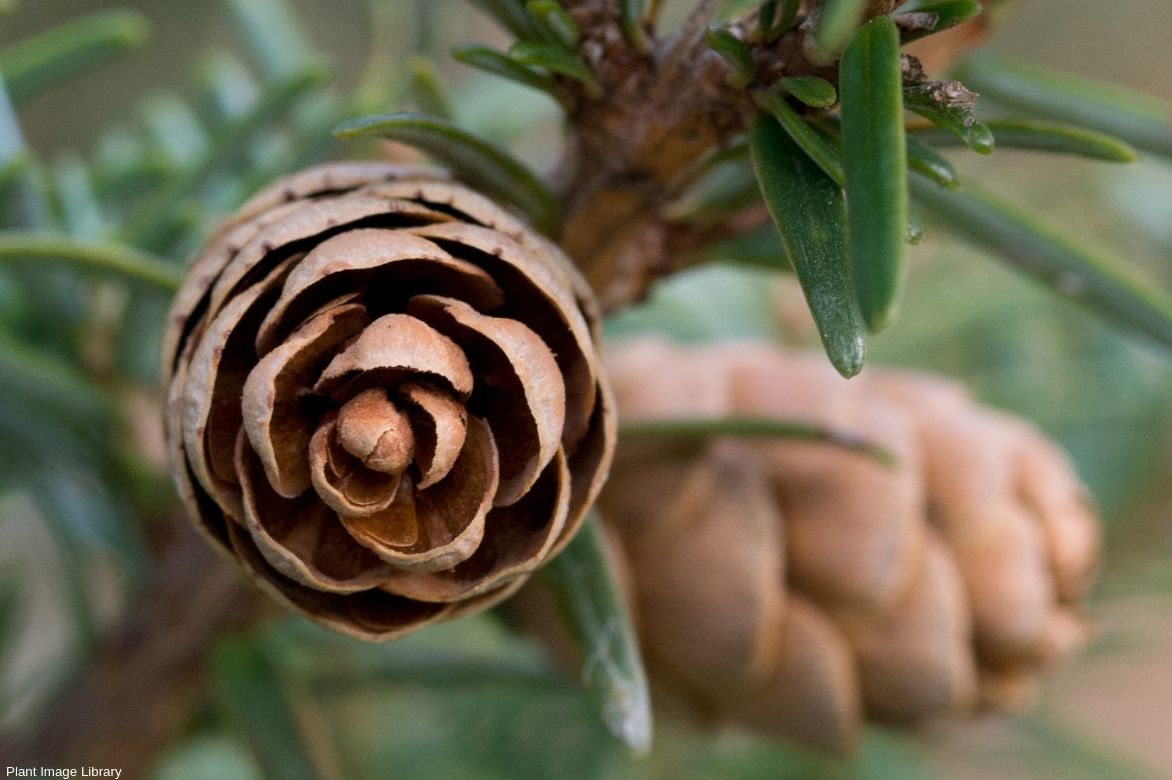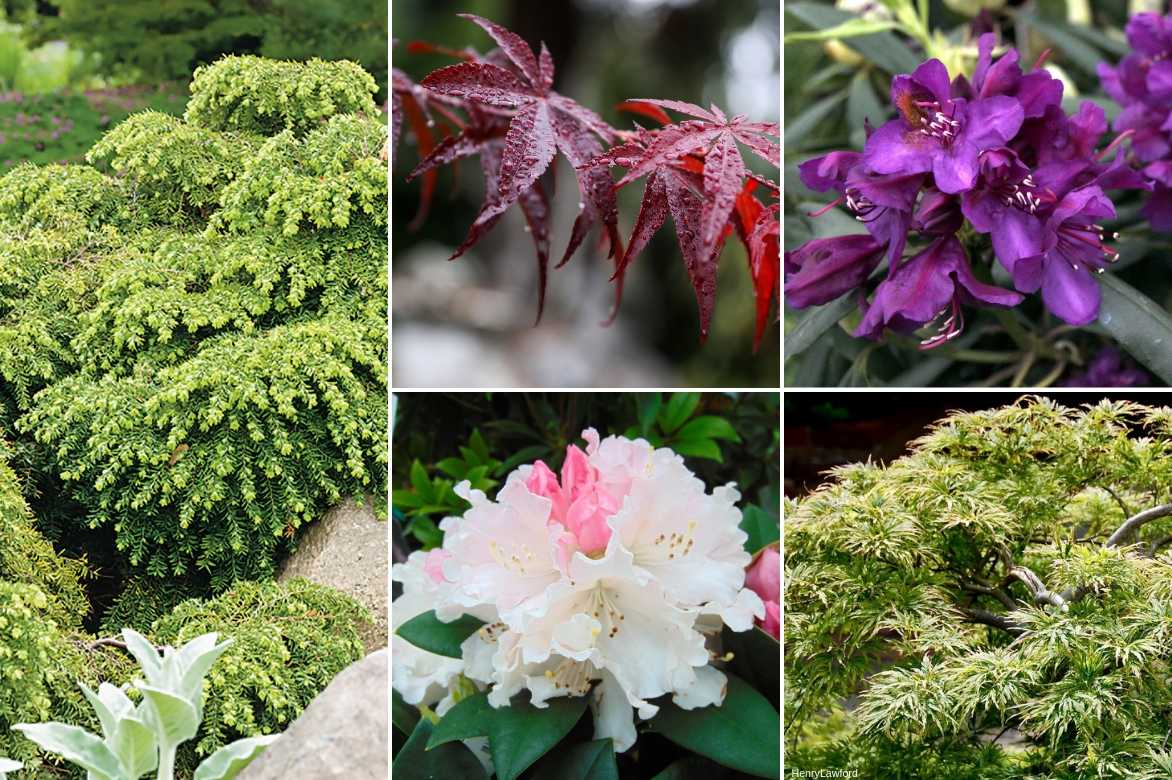
Tsuga, hemlock: planting, pruning and care
Contents
Tsuga or hemlock, in a nutshell
- Hemlocks are majestic evergreen conifers with a pyramidal habit, bearing long, nicely trailing branches, flat needles soft to the touch and many small pendulous cones.
- These 20 to 30 m tall trees are slow-growing and perfect for a north-facing aspect, thriving in a cold, humid climate as in Canada, in humus-bearing, slightly calcareous soil.
- Mainly cultivars of Tsuga canadensis are offered to adorn modest shaded gardens in weeping, bird’s-nest or globe habits…
A word from our expert
Tsuga, or hemlocks are fairly rare and unusual trees or shrubs that have borrowed characters from nearly every genus of conifer. From a distance, they can resemble a Deodar cedar (Cedrus deodara) with a trailing leading shoot, a pyramidal habit bearing long, slightly trailing branches. However, the flat, flexible needles with blunt tips are inserted singly all around the twig, unlike cedars, which bear clustered needles inserted on a small cushion as in spruces. They are sometimes flattened into a plane as in the Canadian hemlock, thus resembling the twig of a fir (Abies) or of a yew (Taxus), which has similarly short needles but with pale green undersides instead of white. They produce small woody pendulous cones reminiscent of those of Douglas-fir (Pseudotsuga menziesii), but the absence of three-toothed bracts between the cone scales allows them to be distinguished, as does their characteristic smell resembling poison hemlock, in contrast to the lemony scent of Douglas-fir foliage.
Hemlock, as the name is used in English, are evergreen conifers of the family Pinaceae like firs, spruces and cedars, but they are endowed with slow growth and a somewhat untidy, flexible habit that sets them apart from other conifers and gives them a particular charm.
They appreciate shade or semi-shade, fresh to moist soils, acidic to slightly calcareous. They can grow alongside leafy trees and even under their shade, spread across the ground to provide shelter for wildlife, act as groundcover on a bank, or trail gracefully over a low wall or a planter. They fit perfectly into Japanese gardens featuring miniature trees such as bonsai with ground carpeted in moss.

Tsuga canadensis
Description and botany
Botanical data
- Latin name Tsuga
- Family Pinaceae
- Common name Hemlock, Tsuga, Canadian hemlock
- Flowering April or May
- Height between 0.30 and 20 m in cultivation
- Sun exposure partial shade or shade
- Soil type any moist soil, acidic to neutral
- Hardiness Excellent (-40 to -20°C)
Hemlocks or Tsuga in Latin, originate from temperate regions of North America, the Himalaya and eastern Asia and include nearly a dozen species, of which three are native to Canada and three to China. Most widespread in gardens is Tsuga canadensis, which grows between Lake Superior and Cape Breton Island within mixed forests and maple stands, always in shade, often beneath the canopy of other trees on moss‑covered soil. It reaches average dimensions of 25–30 m high by 8–10 m wide, with a trunk diameter of 1 m, only 20 m in cultivation. Lifespan reaches 600 years. It is the source of several dwarf cultivars forming graceful mounds of flexible branches such as ‘Jeddeloh’ (80 cm high by 120 cm wide) or ‘Pendula’ (3.5 m high if staked on 5 m spread). Growth is slow in all cases except in western hemlock (Tsuga heterophylla).
Young hemlocks have a dense conical or columnar crown ending in an oblique leading shoot inclined in the direction of prevailing wind and a horizontal or slightly trailing branching habit. With age, architecture becomes more irregular with unevenly spaced branches, dead branches persisting long on the trunk and an uneven crown, giving tree a more supple, graceful habit than spruce or fir. Roots are shallow and spreading. Bark becomes channelled and scaly from an early age and shows purple streaks just after cutting. Initially grey‑brown or silvery and smooth in Tsuga canadensis, it later develops broad ridges and furrows turning reddish‑brown to rusty brown in heterophylla.
Evergreen foliage consists of flat, flexible needles with rounded or notched tips, fairly short, not exceeding 22 mm long. Needles remain on tree 3–10 years before dropping. Narrow lamina narrows abruptly at base into short petiole extended by a small cushion of 3 mm applied along the shoot as in genus Picea.

Tsuga canadensis – botanical illustration
Needles arranged in a spiral around the shoot appear inserted on two ranks with some short needles on upper side in Tsuga canadensis and heterophylla, whereas in subalpine hemlock (Tsuga mertensiana) they form a brush all around the shoot. White bands of stomata clearly mark needle undersides, helping to distinguish them from Taxus (yew) with pale green bands. Young shoots are thin, flexible and pubescent while buds are small (2 mm), ovoid, unlike very acute buds of Pseudotsuga, and non‑resinous.
Male and female cones appear on same tree. Globose male aments about 3 mm appear in lower part of crown, in axils of needles on previous year’s shoots, borne on an unusual scaly peduncle. They release pollen in spring before withering. Small pinkish female conelets, slightly larger than males, appear at tips of short shoots of previous year in upper crown. Pollinated just before new foliar growth, cones then mature within year and hang abundantly at branch ends until following summer while winged seeds are released at year end. In Tsuga canadensis and heterophylla, cones with rounded scales of attractive purplish brown measure only 12–25 mm, whereas in Tsuga mertensiana they reach 30–80 mm.
Wood of Tsuga, pale orange‑yellow, lacks resiniferous canals and is relatively hard compared with most conifers, except wood of species canadensis which is rather soft and whose bark was formerly used for its tannic acid. Wood gives off pleasant smell just after sawing. Western hemlock (Tsuga heterophylla), native to west coast and mountain ranges of North America (Sierra Nevada) up to 1,500 m altitude, is an important forest species used for production of timber (interior cladding, railway sleepers), plywood and pulp, etc., and is also exploited in wetter areas of western Europe. Its growth is faster than Tsuga canadensis. Tsuga heterophylla and Tsuga chinensis (with golden‑green young shoots and shrubby habit) are also very fine species for garden ornament. Tsugas are important as source of food (foliage and seeds) and shelter for wildlife.
Read also
Major diseases and pests of conifersMain Tsuga varieties
Original varieties

Tsuga canadensis Pendula - Eastern Hemlock
- Height at maturity 3,50 m
Dwarf varieties

Tsuga canadensis Cole's Prostrate
- Height at maturity 30 cm

Tsuga canadensis Jeddeloh - Eastern Hemlock
- Height at maturity 80 cm
Discover other Tsuga
View all →Available in 1 sizes
Available in 1 sizes
Available in 1 sizes
Available in 1 sizes
Available in 1 sizes
Available in 1 sizes
Available in 1 sizes
Available in 1 sizes
Available in 1 sizes
Planting
Where to plant hemlock?
Very hardy, Tsuga appreciate north-facing or heavily shaded positions, east-facing sites or within a copse, benefiting from abundant rainfall or near a pond, stream or marsh. Keep them away from buildings or paths because roots are shallow and very spreading. Plant in deep soil rich in organic matter and moist as they do not tolerate drought. Avoid direct afternoon sun as well as urban pollution and wind. Tsuga canadensis ‘Jeddeloh’ will, however, tolerate full sun in cool soil.
Tsuga can be used as free-growing or clipped hedge as it tolerates pruning well.
When to plant?
Prefer autumn (October–November) to plant Tsuga, or February–March.
How to plant?
This plant is easy to grow in cool, shaded conditions. To create a Tsuga hedge, space young plants 1.50 m (pruned) to 3 m (open habit).
- Immerse pot in bucket of water to thoroughly moisten it.
- Dig a wide hole at least three times wider than rootball because roots remain fairly shallow and spread widely.
- Add a few handfuls of sand and gravel to ensure good drainage around roots, which do not like to be waterlogged. Consider planting on a raised mound or within a rockery if necessary.
- Add organic matter and a dressing of horn meal if soil is sandy.
- Place young plant in planting hole.
- Replace soil and firm down lightly.
- Water and mulch generously.

Cones of Tsuga sinensis
Care
- Water Tsuga abundantly during first three years, then during prolonged drought.
- Tsuga needs very little maintenance given its slow growth and robustness against pests and diseases. If grown in a container, apply a special conifer fertiliser every April and hoe the soil in summer to limit evaporation of soil water, or mulch. Beware of mites if air is too dry. Mist the foliage if the needles discolour.
- Simply remove dead wood, which becomes abundant if left unchecked. Its naturally trailing habit does not require pruning, but pruning can be carried out in spring.
Multiplication
Easiest multiplication method is propagation by cuttings of Tsuga in summer–autumn or sowing in spring.
Propagation by cuttings
- Prepare a deep pot by filling it with potting compost mixed with sand.
- Take semi-ripe shoot tips about 10 cm long with a heel.
- Remove leaves near base of cutting and dip base in plant hormone.
- Insert these to two-thirds of their length, avoiding them touching each other.
- Keep them under cover in shade, for example by placing a cut transparent plastic bottle over them.
- In spring, separate rooted cuttings and plant them in bucket which you keep under cold frame until autumn.
Sowing
Sow seeds in a sandy mix and place them under a cold frame.
Uses and companion plants
Species types make very fine solitary specimens with their trailing branches of dark green and a light appearance, a little like Himalayan cedar. Advantage is tree will not try to grow tall to find light. If you live near a forest, deer will prefer to browse the cedar rather than the hemlock.
Tsuga form lovely combinations as in nature with birches, beeches, sugar maples, Weymouth pine (Pinus strobus), spruces such as Picea sitchensis, red spruce (Picea rubens) or white (Picea glauca), Sequoia sempervirens… There are golden-foliaged forms such as Tsuga canadensis ‘Aurea’ that are more compact than the type and can brighten shaded areas.

An idea for an association in acidic soil : Tsuga canadensis ‘Jeddeloh’, Acer palmatum ‘Atropurpureum’, Rhododendron ‘Marcel Menard’, Rhododendron ‘Dream Land’ et Acer palmatum ‘Dissectum’
Specimens such as Tsuga canadensis Pendula create a feature in the middle of a short grass meadow, a large rockery or atop a low wall, forming a large weeping dome, spreading and low, or truly creeping if left to grow naturally. With slow growth, if it grows without gardener intervention, it will not exceed 1 m in height for 5 to 6 m in spread at ripeness. If, however, growth is trained upwards, it will reach 3 to 4 m in height for 5 m in diameter.
Tsuga tolerates pruning well so it can be used as a sumptuous backdrop at the rear of a border or to mark the edge of a copse, as it appreciates the shelter provided by larger specimens.
Its fine foliage of glossy dark green pairs well with the large stones of a rockery that hosts other dwarf conifers, where one can play with scale and colours. Hemlock can also contribute to the setting of a natural pond or a water feature.
Did you know?
The scientific name of hemlock, Tsuga, originally comes from the Japanese name for this tree.
Further reading
Discover our range of Tsuga.
- Subscribe!
- Contents









































Comments